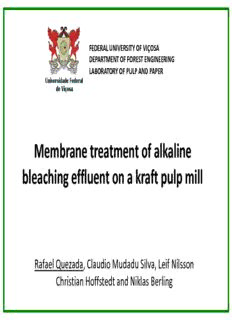
Membrane treatment of alkaline bleaching effluent on a kraft pulp mill PDF
Preview Membrane treatment of alkaline bleaching effluent on a kraft pulp mill
FEDERAL UNIVERSITY OF VIÇOSA DEPARTMENT OF FOREST ENGINEERING LABORATORY OF PULP AND PAPER Membrane treatment of alkaline bleaching effluent on a kraft pulp mill Rafael Quezada, Claudio Mudadu Silva, Leif Nilsson Christian Hoffstedt and Niklas Berling Outline • Introduction • Objectives • Results – Membrane treatment of alkaline bleaching effluent – Effects of the (EPO) membrane filtration on the effluent treatment plant – Membrane permeate recycling to the bleaching plant – Membrane retentate send to black liquor evaporation • Conclusions Effluent generation 1,3 – 6,0 4 – 10 15 – 30 4 – 7 DRYNG COOKING BLEACHING WOODYARD MACHINE 0,5 – 2,0 EVAPORATORS RECOVERY 1,0 – 2,0 BOILER Water consumption Bleaching area: 45.000 m3/d Total: 65.000 m3/d CAUSTICIZING 2,0 – 4,0 Volume (m3/adt) Membrane treatment Module (EPO) filtrate Membrane Retentate Permeate Bleaching sequence D (EPO) D D NaOH D Pre–O 2 Pulp (EPO) D D ClO 2 Acid effluent (EPO) filtrate Alkaline effluent Objectives Evaluate the membrane treatment of (EPO) filtrates from a kraft pulp mill Specific objectives a) Compare three configurations of membrane to treat alkaline (EPO) filtrate of a kraft pulp mill using pilot plants and determine the best operation conditions; b) Study the effect of the (EPO) filtrate membrane treatment on the effluent treatment plant; c) Evaluate the feasibility of recycling of the UF permeate within the bleaching plant; d) Evaluate the feasibility to send the UF retentate to the black liquor evaporation sector Membrane treatment of alkaline bleaching effluent Membrane treatment – Experimental set-up Membrane configuration selection (UF, UF + NF, NF) Optimal condition determination Long-term operation Membrane treatment – Pilot plants Membrane treatment • The nanofiltration membranes require a pre- treatment to reduce temperature and neutralize pH; • In order to select the best option it was considered not only the selectivity but also the costs and operation simplicity; • The selected configuration was ultrafiltration; • The best condition for higher permeate flux (over 200 L/m2h) was 3,0 m/s of cross-flow velocity and 7 bar of TMP, for a COD removal and color of 58% and 91%, respectively.
Description: